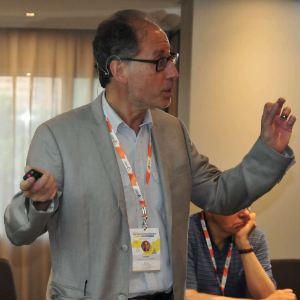Title : Pre-coupling of Receptor Oligomers and Signaling Molecules. Challenging Classical Pharmacology
Abstract:
It has been the general assumption for several decades that the three elements of the most studied transmembrane cell signaling pathway, G protein-coupled receptors (GPCRs), G proteins and adenylyl cyclase (AC), are freely mobile molecules within the plasma membrane that interact by random collision (‘collision coupling’ mode). Two still controversial concepts are changing our classical views of GPCR physiology and pharmacology: pre-coupling and GPCR oligomerization. Pre-coupling implies that GPCRs, G proteins and the effectors are pre-coupled before receptor activation and that they do not dissociate upon activation. In addition, the phenomenon of GPCR homo- and heteromerization is becoming widely accepted. A GPCR homodimer and its cognate G protein provides a main functional symmetric unit and oligomeric entities can be viewed as multiples of dimers. A GPCR heterotetramer constituted by two molecularly different homodimers coupled to their cognate G protein and to AC seems to constitute a common structure of a GPCR heteromer. Our recent studies indicate that the canonical Gs-Gi interaction at the AC level is a specific property of the GPCR heterotetramer. In addition to the allosteric properties of ligands demonstrated when considering GPCR as putative monomeric entities, such as probe dependence and functional selectivity, GPCR heteromerization includes the possibility of allosteric interactions between different orthosteric ligands, wproviding utmost potential for drug development. The evidence for GPCR oligomerization and the elucidation of symmetrical minimal functional units of GPCR homomers and heteromers, promotes oligomerization and allosterism within GPCR oligomers as necessary elements in the research of GPCR physiology and pharmacology.
Audience Take away:
1. Classical concepts of GPCR physiology and pharmacology need to be revisited to include the concepts of ‘pre-coupling’ and ‘GPCR oligomerization’
2. GPCR heteromers uncover a previously unforeseen vast number of new possible subpopulations of GPCR subtypes, with specific neuronal localizations and functions.
3. GPCR heteromers represent new targets for drug development, providing utmost potential in the discovery of more efficacious compounds for the treatment of neuropsychiatric disorders




